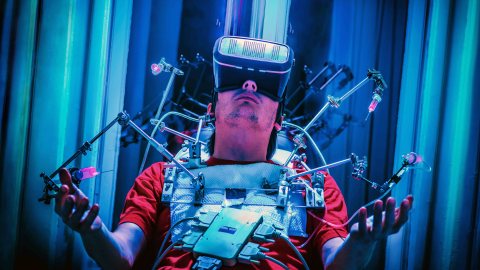The History of Brainwashing Is a Red Flag for Techno-therapy

For Donald Ewen Cameron—a Scottish-born psychiatrist, the president of numerous medical societies, and the director of the Allan Memorial Institute in Montreal between 1943 and 1965—technology was a passion bordering on an obsession. While his tattered tweed suits and mismatched socks lent him the air of an absent-minded university don, Cameron was fixated on the future, from his collection of high-powered cars, to his constant use of Dictaphones, to the science-fiction novels that littered his bedside table. As this ‘technophilia’ deepened and began to shape his psychiatric thinking in the 1950s, Cameron was set on a collision course with Cold War conspiracy.
Beyond its capacity to simplify everyday life, Cameron believed that technology could be the handmaiden of a psychiatric revolution. Denouncing conventional therapy—with all its talking, listening, and trust-building—as slow and ineffective, Cameron instead subjected his patients to a radical new treatment that promised to accelerate the process of psychological healing. Termed ‘psychic driving’, this treatment utilized a brand-new technological savior: the reel-to-reel tape machine.
Psychic driving was a two-stage process. Firstly, distressing memories and pathological behaviors were ‘annihilated’ from the patient’s mind through an unrelenting regime of electroconvulsive therapy (ECT). While most of his peers conservatively limited ECT to 12 shocks per month to avoid damaging short-term memories, Cameron increased this to 12 shocks per day to capitalize on this usually unwanted side-effect. Then, patients were placed in front of tape machines emitting endlessly looping messages designed to push them towards particular psychiatric epiphanies. ‘Peggy, you have discovered that your mother never wanted you,’ one such tape proclaimed. ‘Can you see now why you have given affection in such lavish degree to your children and why you became so desperately anxious when your daughter decided to enter a convent?’
Messages were repeated for days, weeks, and even months on end, in order to overwhelm the patient’s conscious defenses. When patients became distressed by the relentless repetitions, they were restrained using a variety of crude and bizarre methods, from securing their headphones with tape to immobilizing them with hallucinogenic substances. The results were devastating: rather than overcoming their conditions, patients often emerged with severe memory loss, unable even to recognize their own families.
Cameron’s research attracted a number of patrons, none more surprising than the Central Intelligence Agency (CIA). Following the return of seemingly ‘brainwashed’ prisoners from the Korean War in 1953, the CIA had begun funding universities and hospitals engaged in research concerning behavioural modification. The project, codenamed MK-ULTRA, was designed to produce interrogation techniques for Cold War espionage. As such, Cameron’s proclaimed ability to deconstruct and remake minds at will seemed too good an opportunity to pass up, and nearly $60,000 was funnelled into psychic driving between 1957 and 1960. However, as the treatment’s destructive effects became apparent, the CIA realised psychic driving would have little operational use, and ties were swiftly broken. The CIA’s involvement in Cameron’s work would lay hidden until an explosion of class-action lawsuits in the 1980s.
Cameron’s faith in psychic driving, sustained by the fantasy of a futuristic, mechanised psychiatry, outweighed the mounting evidence of its total failure. Rather than emerging out of a comprehensive psychological theory, Cameron’s tape-machine treatments were largely inspired by novels such as Aldous Huxley’s Brave New World (1931) and adverts for ‘sleep-teaching’ records that dubiously claimed to impart fluency in foreign languages overnight. Doggedly pursuing an ‘automated’ psychiatry that moved beyond the discussions of the chaise longue and towards an assembly line of mass-produced wellbeing, Cameron seemed oblivious to the harm being caused.
Through its ‘stranger-than-fiction’ quality, psychic driving pushes us towards a more critical history of psychiatry in the 20th century. Far from psychiatry being a neutral, and purely objective endeavour, set apart from the messy reality of politics and culture, psychic driving reveals how knowledge about the human mind is profoundly shaped by the concerns and priorities of the societies that produce it. This is far from a new perspective, with similar arguments persuasively made more than half a century ago in The Myth of Mental Illness (1961) by the psychiatrist Thomas Szasz and in Madness and Civilization (1964) by Michel Foucault. The history of psychic driving extends these critiques, revealing how the political pressures and moral panics of the Cold War shaped perceptions of mental illness and its treatment.
Psychic driving might also tell us something about the future, not just the past, of psychological therapy. Few present-day psychiatrists find themselves preoccupied with issues of communism and brainwashing, but Cameron’s core belief in the inevitable merging of technology and psychiatry has proven remarkably resilient. This is perhaps seen most dramatically in the recent explosion of smartphone applications concerned with mental health, with some 10,000 apps on the market offering everything from mood trackers to mindfulness programs, ambient noise generators to automated hypnosis. Enthusiastic advocates have been quick to praise these pocket-sized therapies as a timely solution to the budgetary pressures and long waiting lists of overstretched mental health services.
However, psychic driving introduces a note of caution to these celebrations. While exotic conspiracies of international espionage are unlikely to be uncovered, Cameron’s work reminds us that we ought to question whose interests, beyond benevolent ‘healing’, are at play. Beneath the optimistic rhetoric of this new wave of ‘techno-therapy’ there is plenty to worry about: applications frequently lack expert medical oversight, few are supported by reliable studies gauging their effectiveness or even basic safety, and many have been found to leak or actively sell users’ sensitive health data to third parties. Clearly such issues must be interrogated further, and the history of psychic driving can bolster the necessary skepticism—and dissent—to do so.
Sam Hatchwell and David Saunders’ Psychic Driving Installation at the Museum of the Normal
More information on the project can be found here

—
This article was originally published at Aeon and has been republished under Creative Commons.





